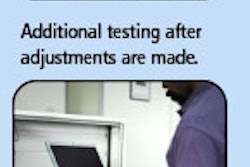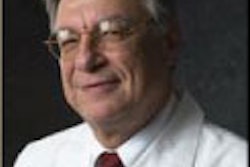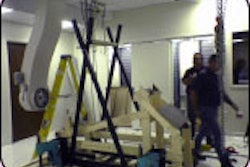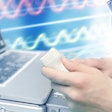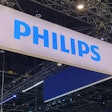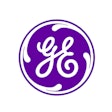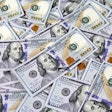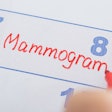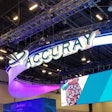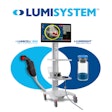CT developers have tried for years to find the perfect balance between speed and power. But their vision for a device that could combine both was limited by existing technology. The new generation of dual-source CT (DSCT) scanners may have taken a major step toward solving the speed-power conundrum.
Rather than achieving faster scanning by adding additional detector rows, DSCT instead uses two x-ray tubes and two detector arrays in one gantry, mounted at 90° angles. The result is a system that can take accurate images of the heart without the use of beta-blockers; differentiate between vasculature, bone, and soft tissue; and offer patients who might have previously been ineligible for CT -- such as obese individuals or those with arrhythmia -- access to CT technology.
-- Dr. William Muhr, South Jersey Radiology Associates, Voorhees, NJ
There's a price for all this performance. DSCT can cost about twice as much as a 64-slice CT unit. Is it worth it? The answer is yes, if a facility wants to step up its coronary workflow, according to Dr. William Muhr, a staff radiologist at South Jersey Radiology Associates in Voorhees, NJ.
"The CT slice wars have been geared to coronary imaging, no doubt about it," Muhr said. "Short of coronary scans, the vast majority of CT exams can be done perfectly well on 16-slice. But if you want to do coronary CT and are trying to run a full CT schedule, dual-source will solve a lot of problems."
To date, DSCT's benefits have been shown primarily in imaging the heart, one of the most challenging parts of the body to image accurately due to the need to manage patients' heart rates with beta-blockers and thus reduce image artifacts. DSCT's temporal resolution is 83 msec per slice, compared to about 160 msec on a 64-slice CT unit -- and with the use of multisector reconstruction algorithms, the resolution can be reduced even further, to 42 msec. DSCT can acquire a cardiac image in a breath-hold of five to six seconds, rather than the 10 seconds a 64-slice system requires.
This speed allows doctors to image patients without having to lower their heart rates with beta-blockers, which is good news for patients who can't handle the drugs, such as those with hypotension, asthma, or mild forms of heart failure. DSCT also allows for imaging patients with irregular heart rates, since the better temporal resolution produces motion-free images regardless of the cardiac phase, according to Dr. U. Joseph Schoepf, an associate professor of radiology and medicine at the Medical University of South Carolina (MUSC) in Charleston. Schoepf's facility began using DSCT in October of last year.
"We had a guy come in within the first few days our DSCT unit was up and running, a fellow radiologist in his 40s, with chest pain, shortness of breath," he said. "He was on the table, ready for the exam with a nice and slow heart rate in the sixties. When the contrast was administered, he panicked, and his heart rate shot up to 140 beats per minute. But we still got beautiful diagnostic images. Once I saw that, I thought, let's just drop the beta-blockers."
MUSC has subsequently stopped using beta-blockers entirely for patients undergoing coronary CT angiography (CTA) with DSCT.

"With the DSCT unit, our cardiac exams take about 10 to 15 minutes from the time the patient arrives in the radiology department."
-- Dr. Ahmed Farag, Lake Forest Hospital, Lake Forest, IL
Not only can DSCT rapidly produce diagnostic images of the heart, it can help ease workflow as well, according to Dr. Ahmed Farag, vice chairman of the department of radiology at Lake Forest Hospital in Lake Forest, IL. The facility's DSCT unit went live in January, and is the only CT device in the hospital.
"One of the key issues for us in choosing to install DSCT was throughput," Farag said. "With a 64-slice CT scanner, we would have to monitor patients once they'd been given the beta-blockers, and wait until their heart rates were low enough to scan. Sometimes it could take as long as an hour and a half, with the patient on the table. With the DSCT unit, our cardiac exams take about 10 to 15 minutes from the time the patient arrives in the radiology department."

"Since (DSCT) eliminates the biggest problem with cardiac CT, the heart rate issue, it makes cardiac CT a regular CT scan."
-- Dr. Elliott Fishman, Johns Hopkins University, Baltimore
The ability to make cardiac imaging a routine part of a hospital's overall CT scanning is a boon for radiologists, according to Dr. Elliott Fishman, director of diagnostic imaging and body CT in the department of radiology at Johns Hopkins University School of Medicine in Baltimore, MD.
"The DSCT device is easy to use, and there's been virtually no downtime," Fishman said. "And since it eliminates the biggest problem with cardiac CT, the heart rate issue, it makes cardiac CT a regular CT scan."
Sixty-four-slice technology requires radiologists to look for the heart's quiet phases to minimize artifacts, according to Schoepf.
"Because there are two tubes in the gantry (of the DSCT unit), the image quality is stable at all heart rates," he said. "There's a better chance of capturing a crisp and clear image of the coronary arteries, regardless of the heart phase. We also have a better chance at detecting coronary artery stenosis and visualizing the smaller side branches of the heart. And there are less artifacts from dense calcifications and stents if they move less."
Not all of DSCT's users are abandoning beta-blockers, however. Dr. John Lesser, director of cardiovascular MRI and CT at the Minneapolis Heart Institute at Abbott Northwestern Hospital in Minnesota, and his colleagues continue to use them with their facility's DSCT unit, which has been in service since January. Beta-blockers help decrease micromotion of the coronary arteries and create uniformly excellent studies, according to Lesser.
"If we don't use beta-blockers, the likelihood of getting a great study drops," Lesser said.
Like 64-slice CT, DSCT offers the capability of ECG pulsing, or adapting the radiation dose to the heart's rhythms, decreasing the dose during the systolic phase of the heart's cycle. But DSCT allows for this pulsing technique no matter what the heart rate, according to Farag. DSCT also adapts the table speed to the patient's heart rate, so that patients with faster heart rates have a faster table speed, which also minimizes radiation exposure.
Not just for hearts
In addition to heart imaging, DSCT offers other clinical benefits. Angiography, for one, according to Farag.
"With regards to the speed DSCT offers, anything in CT angiography is a huge home run with the technology," he said. "It can do peripheral runoffs from the diaphragm to the toes in 36 seconds." Farag's hospital is already using DSCT to perform angiography exams.
And its speed seems to make DSCT a natural for acute care and emergency room applications -- any situation in which patients can't necessarily hold their breath or lie still for long. DSCT's two imaging tubes offer clinicians a way to better image obese patients by increasing the scanner's energy and therefore acquire better images. And the technology includes scanning features that allow a radiologist to change the tube current on the fly, an important feature for patients with acute chest pain, according to Schoepf.
"When you're using 64-slice for a triple rule-out exam, the radiation dose is increased because you're scanning the entire chest," Schoepf said. "But you can program the DSCT unit to use the full radiation dose when scanning the heart area, and to decrease the tube current, and therefore the dose, when scanning other areas of the chest."
One downside of DSCT's speed is that its scan time can outrun the contrast bolus, Farag said.
"We had to curb the speed of the 64-slice CT scanner to that of a 16-slice to keep pace with the bolus for peripheral runoff studies," he said. "DSCT has the same issue, so you fix the scan time for 30 seconds, and slow it down."
You get what you pay for
As DSCT permeates into the clinical mainstream, radiologists are finding that the technology boosts the quality and efficiency of CT imaging in routine clinical settings, and opens up CT to patients who previously would have been ineligible. And these benefits may prove compelling enough to outweigh the technology's high price tag.
"The improvements in cardiac alone are worth the investment," Fishman said.
By Kate Madden Yee
AuntMinnie.com contributing writer
March 1, 2007
Copyright © 2007 AuntMinnie.com




